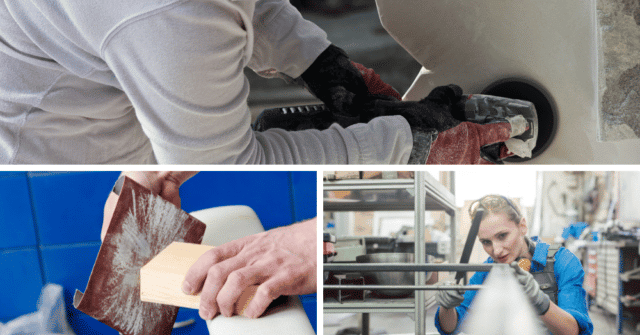Belt sanders
In both sandpaper and fibre, sanding belts, also known as sanding belts, are an excellent choice for robots, hand tools and other applications, backstands or calibrating machines. Our belts are renowned in the market for their bonding durability and for being custom made to our users’ specifications. We can manufacture segmented belts, wave-cut (wave-cut) y overlapamong many others.
Sanding belts are used on pneumatic and electric tools and serve to remove surfaces, achieve finishing, roughing or cleaning in a short time.
Our abrasive belts are made with pre-studied, tested and adapted joints for each application to be carried out. The joints used in our sanding belts, with cloth and paper backing, give the machine used maximum performance in the process and remarkable finishes in all types of applications depending on the abrasive selected.
What type of belt sandpaper to choose?
There are different types of belt grinders. These are manufactured with special dimensions and specifications for all types of applications. We offer different widths, lengths, minerals and backing types for your design.
Grit type of belt grits
The grit type of our sandpaper will generate a specific result depending on the grit type chosen. Coarser grits are represented by smaller numbers and are for detail and hard surfaces. On the other hand, coarser grits are named with larger numbers and are often the best choice for fast sanding and large surfaces.
It is recommended to select a coarse grit of 40 grit for hard or heavy roughing applications, 60 or 80 grit for intermediate applications and 100 or 120 grit for finishing applications. For non-ferrous metals, plastics, lacquer, paint and glass we recommend a 400 grit belt.
Sizes of belt grits
Depending on their dimensions, belt grinders can be classified into the following categories:
- Mini-belts or narrow belts, with a length of not more than 690 mm
- Short belts, which can have a length of 690 mm up to 3.000 mm
- Wide belts with a width of 300 mm up to 1,600 mm
- Segmented belts, usually longer than 1,600 mm in length
The wide belt sandpaper work very well on veneered surfaces, plywood, soft or hardwoods, and can be used in different sanding methods to achieve calibrated or good finishes.
They are often preferred for treating wood when removing varnish defects and sanding high wood fibres. They are most commonly used on calibrating machines.
The short belt sanders short belts work very well when sanding refractory materials and stainless steel. Their sanding can be aggressive on hard materials.
Materials in belt sanding belts
The size of the abrasive belts is not the only factor to take into account when working with a surface. Another very important factor is the material our sandpaper is made of.
- Wood sanding belts: For treating wood, veneer, melamine, iron or leather, the ideal choice is to use aluminium oxide belt sandpaper.
- Belt sandpaper for metal: For metal it is best to use aluminium oxide, zirconia or ceramic sandpaper.
Sanding belts for other surfaces: For varnish, stone, marble, granite, ceramic, rubber, plastic, bronze, copper, brass or glass, a silicon carbide sandpaper is a very good choice. For stainless steels, cast iron, aluminium or zamak, we recommend zirconium sandpaper. And for stainless steels, cast iron, aluminium and titanium alloys, a ceramic one.

Belt sanders
Belt sanders are machines that work to make use of the abrasive belts of the abrasive belts. There are many types of belt sanders and they all have the same function: to continuously rotate a sanding belt over a surface to remove material in a short time.
Belt sanders can be electric or pneumatic. The latter, instead of requiring electricity to operate, use an air compressor with sufficient power to achieve the necessary speed to carry out our operation.
Belt sanders can be divided mainly into three sizes: the smallest are handheld or portable sanders; the next in size are bench sanders (also known as backstand or backstand)and the largest of all are known as horizontal pedestal sanders.
The main characteristic of portable sanders is that they are the ones that we must bring close to the material we are going to work on, which usually remains in a fixed point. With them we can sand floors, furniture, walls or fences, among other objects that are difficult to handle or transport.
Some popular models of handheld sanders are the grinder and the mini-belt or narrow belt sanders. The latter are the smallest form of handheld sanders.
On the other hand, bench belt sanders and horizontal sanders are stationary sanders. When using them, it is the material that we will be working on that we will be transporting and bringing closer to them, as they are static machines.
Horizontal sanders are ideal for professional industrial work on metal and wood. They have a high capacity for deburring edges and cleaning weld seams.
Other special stationary machines for abrasive belts are calibrating machines (also known as wide belt sanders); central suction sanders, especially for wood; and square orbital sanders, also for woodworking.


